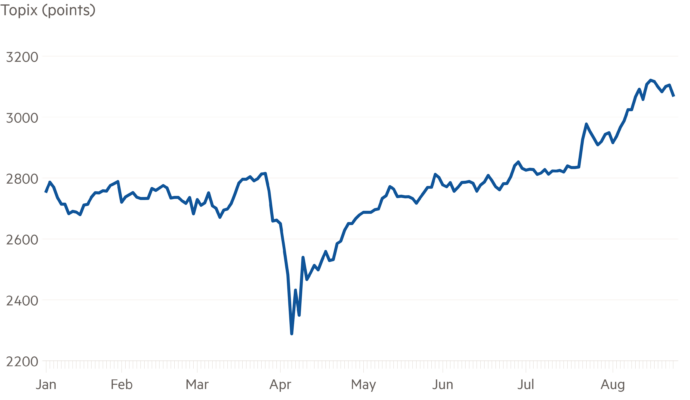Stay informed with free updates
Simply sign up to the Foreign exchange myFT Digest — delivered directly to your inbox.
Taiwan’s dollar jumped more than 2 per cent in volatile trading on Tuesday, as the country’s massive life insurance and export sectors rushed to contain the fallout from a weak US currency.
The New Taiwan dollar closed 2.5 per cent stronger against the US dollar, at NT$29.16, making its biggest single-day gain since a rapid appreciation at the start of May that exposed Taiwanese life insurers to huge losses on their US assets.
Taiwan’s life insurers hold $1.7tn in overseas assets, most of which are US bonds, meaning they have been heavily exposed to a slide in the greenback, which has suffered its worst start to the year since 1973. Taiwan’s dollar is up more than 11 per cent against its US counterpart so far this year.
Tuesday’s move was likely to have been driven by insurers hedging their exposure to a weakening US dollar by buying forwards on Taiwan’s currency, said Chandresh Jain, emerging markets rates and foreign exchange strategist at BNP Paribas.
“The ongoing narrative of Taiwanese lifer hedging could be playing out and there is also an element of broad USD weakness,” said Saktiandi Supaat, head of forex research at Maybank. “These themes tend to be self-reinforcing in nature.”
The rally in Taiwan’s dollar came after a sharp weakening on Monday, when the currency closed 2.5 per cent lower following what many analysts said was intervention by the central bank.
“The market has a suspicion the central bank has started to intervene,” said Lemon Zhang, forex and emerging markets macro strategist at Barclays.
A sharply appreciating currency poses a threat to Taiwan’s large export sector. The country’s $475bn of outbound goods last year comprised about 60 per cent of GDP, substantially higher than the global average of 29 per cent, according to the World Bank.
Last month, Taiwan’s central bank warned local importers and exporters against speculating on the exchange rate, which they said “could intensify exchange rate fluctuations, ultimately harming their own interests”.
A weaker US dollar has added to appreciation pressure for the currencies of other Asian countries with large holdings of overseas assets, including Japan, South Korea and Singapore.
BNP’s Jain noted that in the past two months, Taiwan’s life insurers had been using “proxy hedges” to short the US dollar through other currencies, betting that the South Korean won or Singapore dollar might appreciate faster than Taiwan’s dollar, but they were now starting to hedge in their home currency again.
“Dollar-Taiwan kept moving faster than their proxy hedges,” Jain said. “They started coming back.”
Analysts said they believed Taiwan’s life insurers would continue to use the South Korean won as a proxy hedge, which could lead to that currency’s appreciation.
The won has risen more than 8 per cent against the US dollar this year, boosted by inflows to South Korean equities and expectations of fiscal expansion after a new government was elected last month.
“People think Korea can repeat what happened to Taiwan,” said Barclays’ Zhang.
Foreign investors, including Taiwanese life insurers, appear to be hedging their exposure but not selling their US assets, said Dhiraj Nim, economist and foreign exchange strategist at ANZ, adding that he expected investors to rotate more of their assets into emerging markets over time.
“The problem is alternatives,” said Nim. “What are the alternatives to US Treasuries?”


